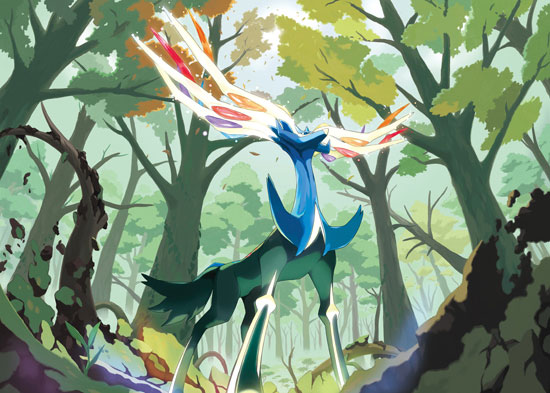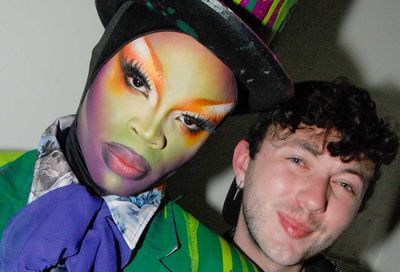Battle Tested
After 15 years, it's immensely pleasurable to see just how far Pokémon has evolved since its 8-bit origins on the Game Boy
After 15 years and five installments, Game Freak has released a sixth edition to the Pokémon canon of games that originated with Red/Blue and finds itself present today in Pokémon X/Y. As with past entries, much of the formula will be familiar to series regulars, but X/Y also adds a plethora of fresh content to keep fans and newbies alike excited. X/Y is technically two separate games, and for the completionists among you both are a necessary purchase, as each offers unique Pokémon to capture and exclusive items to tempt your exploratory side.
“Wait,” you may be thinking, “Isn’t Pokémon for kids?” Well, I’m a mid-20s college graduate, and I’m still captivated by Pokémon. I’m not alone, either — don’t let the cutesy, cartoon appearance fool you, Pokémon is a hands-on, full-bore RPG that manages to be both technical and competitive, and can appeal to kids and adults alike. Small wonder it’s one of Nintendo’s most lucrative and successful properties.

Pokémon X/Y‘s premise is similar to many of its predecessors. You begin as a nobody, explore your region and capture many and varied Pokémon, training them and battling gym leaders to test your strength. These mini-battles lead to the final boss battles, involving the Elite Four. Defeat them, and you become Pokémon master — and, really, who doesn’t want that as their title? Okay, so the narrative is pretty much copy-and-pasted from past installments, with the odd divergent side story tacked on along the way — though these all become pretty forgettable. The setup is that your character has recently moved to the Kalos region and within days has established a nemesis in your neighbor, met several forgettable friends and gained your first Pokémon. Moving is so stressful.
From there, you meet a professor who sets you the task of traveling the area, capturing and documenting the various Pokémon you encounter. This plotline eventually focuses on befriending your archrival, the mysterious properties of Mega Evolution, and an evil organization called Team Flare and their desire to steal powerful Pokémon and any valuable resources, using both to destroy the world and recreate it to their liking. Kalos region really isn’t looking like such a great move anymore.
That’s pretty much where the story ends, with its linear format grinding to a halt once the Elite Four are encountered and defeated. Following your victory, though, is the meat and bones of Pokémon X/Y. After the final battle, the entire world opens up, allowing you to make your own story. You can choose to focus on capturing every Pokémon and filling your Pokedex — which collects data on every Pokémon you capture or encounter — or training your Pokémon and taking them online to battle competitively.
Pokémon‘s gameplay is standard turn-based RPG fare, with you and your opponent taking turns attacking one another or boosting your own stats. Standard as it is, Pokémon makes the most of its system with incredible depth. You can only carry six Pokémon at any time, so strategy is key. Each Pokémon takes turns battling, similar to Final Fantasy and other JRPGs, and the speed of individual Pokémon determines which goes first. Battling is relatively straightforward, with each Pokémon utilizing four moves to attack, defend, boost or lower stats or even add passives that last for a couple of rounds.
The strategy aspect furthers the depth of each battle. Each Pokémon has a specific type — Water, Grass, Dark, Fighting, etc. — with each type stronger against one and weaker against another. Fire, for instance, is strong against Grass but vulnerable to Water. Their attacks follow similar types, with Fire attacks doing more damage to a Grass Pokémon and so on. In total, there are 18 types, including a new Fairy type that is strong against Dragons but vulnerable to Steel.
Battling, and knowing your strengths and limitations therein, is essential when playing Pokémon, particularly online. If an opponent uses a type strong against yours, you must decide whether to use a different Pokémon to counter, or go for the kill and risk defeat. The same logic carries to every battle, whether online, NPC or with random Pokémon met in the wild. Wild encounters add an extra layer — you can either defeat the Pokémon for experience points, or leave them in a critical state and capture them. Not all Pokémon are easily captured, but if you’re successful they can be raised, trained and used for battles in future — or, you can devote your time to simply collecting them all. Pokémon are cooler than stamps, after all.
Following a battle, should you be victorious, your Pokémon will gain experience points. These points in turn level your Pokémon, enabling them to learn better moves or evolve into more advanced versions of themselves. While many Pokémon can evolve up to three times, some are restricted and several can’t evolve at all. Following this, a new addition to X/Y is Mega Evolution. These are temporary evolution states, usable in battle — and again not all Pokémon have access to them — which allow Pokémon to change form, boosting stats or learning new abilities, helping to change the balance of power in a fight. The downside here is that, while impressive in theory, the reality is more of a cosmetic gimmick and it’s limited by its once-per-battle use. It’s a nice change of pace in the middle of a fight, but it’s an unnecessary one.
That’s not the only flaw in Pokémon X/Y. While graphics are significantly improved this time around, the new content is very much hit or miss, with many additions feeling pointless. Pokémon-Amie is a Tamagotchi-esque addition that allows players to interact with their Pokémon, petting them, feeding them cake and playing games. Cute and initially endearing, but ultimately redundant despite the minor bonuses it grants players during battles. All of the new content has impacted frame rate, too, which often slows down animations during intense battles and when there are a lot of items on-screen. Find yourself in a battle with a Fire Pokémon, whose body is partially engulfed in moving flames, and an Avian, which will continuously flap its wings, and the fast-paced battle will grind to a slow crawl. It’s not a constant problem, but when it occurs it’s noticeably distracting. That said, the graphics are, for the most part, gorgeous. Utilizing the power of the 3DS, for the first time in the series Pokémon are rendered in full 3D models. For someone used to 2D sprites, it adds a whole new layer.
Difficulty settings can also produce some irks. This is the biggest disappointment you’ll encounter inPokémon X/Y. Let me preface this by saying that Pokémon games don’t place a great focus on difficulty. Catching Pokémon, training them for battle, exploring the world — that was always the main focus. However, I’d be remiss if I didn’t say I craved some additional difficulty or challenge when battling other characters in-game. Halfway through X/Y it became clear that the game’s designers are still stuck in the youth-oriented mindset associated with Pokémon — this is most evident in the battles with each gym leader, where, if you’re playing properly, your Pokémon will likely already be maxed out and you can easily win without breaking a sweat. I want to see the designers bake in a difficulty setting so that experienced players can make the game harder and offer more of a challenge. That’s not to say that the whole game is a cakewalk. Training Pokémon is an impressive challenge that requires time and effort to raise the stats and prowess of each individual Pokémon. This can be furthered by breeding Pokémon, choosing compatible parents and balancing character traits to produce the ultimate fighter. Still, if the resulting battle is so easy, why bother?
Quibbles aside, Pokémon is still a game that you can sink countless hours into. Replay value is very strong, as the need to see and capture every Pokémon remains as addictive as it has ever been. There are more than 700 Pokémon in total, so you’re going to be here a while. That addiction is hard to describe, but every time a Pokémon would pop up on-screen, I felt a burning need to capture it, train it and make it my own.
This obsession can then carry you through to the online portion of the game, where Pokémon can be traded with other gamers, allowing everyone to expand their collections through a sort of Pokémon-based file-sharing system. Not all Pokémon are available in-game, so the incentive to go online and actively participate in the trading system is there for those desperate to fill their collections. Those collected Pokémon will pay dividends in the backbone of Pokémon X/Y — online battles. A way to demonstrate your skill at training and fighting, online tournaments, rankings and additional training options help cement player-versus-player combat as the true time-sink of Pokémon. You can lose hours training, fighting and collecting, then training and fighting again as you attempt to increase your world ranking. It’s also a great measure of your current skill. I frequently lost battles, seeing each loss as a reason to further train and advance my Pokémon. It’s seriously habit-forming.
Really, that’s why I love Pokémon so much. Graphics and story and glitches aside, the core gameplay and the attachment I form to my Pokémon are what keep me returning for more. I started with nothing and was given a Pokémon by my in-game friends. My choice? The Frog, of course, because frogs are cool. From there, I was let loose into a world of monsters to fight, capture and add to my roster. With over 700 potential Pokémon it makes it that much harder to distill it down to the six you are limited to carrying. On my travels, I changed my setup at least four times. My Frog was swapped for a Barnacle being with five heads, which in turn gave way to a Fire Bird resembling a robin, which was ultimately shunted in favor of a bipedal fighting chicken. Naturally. Sadly, he too was kicked out and swapped for a Dinosaur with a flower on its back, which in turn became a levitating Venus flytrap with eyes, who succumbed to a floating sword with one eye, until ultimately I settled on a monster that resembled a drag queen. Again, naturally. My point is that your core game is constantly changing as you swap out Pokémon and advance your lineup of fighters. After 70 hours of gameplay, I have an immense attachment and a sense of accomplishment as I train my monsters and watch them compete in battles. Pokémon is a game entirely about the journey, the quest to be the very best, both in-game and online, and that’s why it’s so addicting.
After 15 years, it’s immensely pleasurable to see just how far Pokémon has evolved since its 8-bit origins on the Game Boy. Playing Pokémon X/Y invoked a heady sense of nostalgia as old favorites shone in their new 3D skins, vibrant colors and (mostly) smooth animations bringing them to life in my hands. This latest installment is testament to the longevity of the Pokémon series, its success among gamers, old and new, proving that there’s still room for the series to evolve further. Don’t be put off by its young audience, don’t be distracted by its cutesy look or cartoonish graphics. Pick up a 3DS and dive into a complex world of strategy that will sink into your subconscious and leave you hungry for more. Pokémon has evolved, and it’s time you joined the fight.
Support Metro Weekly’s Journalism
These are challenging times for news organizations. And yet it’s crucial we stay active and provide vital resources and information to both our local readers and the world. So won’t you please take a moment and consider supporting Metro Weekly with a membership? For as little as $5 a month, you can help ensure Metro Weekly magazine and MetroWeekly.com remain free, viable resources as we provide the best, most diverse, culturally-resonant LGBTQ coverage in both the D.C. region and around the world. Memberships come with exclusive perks and discounts, your own personal digital delivery of each week’s magazine (and an archive), access to our Member's Lounge when it launches this fall, and exclusive members-only items like Metro Weekly Membership Mugs and Tote Bags! Check out all our membership levels here and please join us today!






















